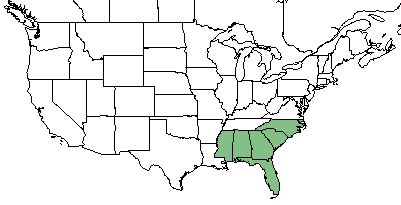Difference between revisions of "Andropogon tracyi"
(→Description) |
|||
| Line 42: | Line 42: | ||
===Use by animals=== <!--Herbivory, granivory, insect hosting, etc.--> | ===Use by animals=== <!--Herbivory, granivory, insect hosting, etc.--> | ||
| − | ''A. tracyi'' is used by quail species in the community for nesting, providing protection for the young from predators <ref name= "Harshbarger"> Harshbarger, T. J. and R. C. Simpson (1970). Late-summer nesting sites of quail in south Georgia, Southeastern Forest Experiment Station, U.S. Department of Agriculture, Forest Service. </ref> | + | ''A. tracyi'' is used by quail species in the community for nesting, providing protection for the young from predators.<ref name= "Harshbarger"> Harshbarger, T. J. and R. C. Simpson (1970). Late-summer nesting sites of quail in south Georgia, Southeastern Forest Experiment Station, U.S. Department of Agriculture, Forest Service. </ref> |
<!--==Diseases and parasites==--> | <!--==Diseases and parasites==--> | ||
Revision as of 13:47, 29 April 2019
Common name: Tracy's bluestem
| Andropogon tracyi | |
|---|---|
Error creating thumbnail: Unable to save thumbnail to destination
| |
| Photo by the Atlas of Florida Plants Database | |
| Scientific classification | |
| Kingdom: | Plantae |
| Division: | Magnoliophyta - Flowering plants |
| Class: | Liliopsida - Moncots |
| Order: | Cyperales |
| Family: | Poaceae |
| Genus: | Andropogon |
| Species: | A. tracyi |
| Binomial name | |
| Andropogon tracyi Nash | |

| |
| Natural range of Andropogon tracyi from USDA NRCS Plants Database. | |
Contents
Taxonomic Notes
Synonyms: none
Varieties: none
Description
A. tracyi is a graminoid perennial that is a member of the Poaceae family [1]. Like other species in the genus, A. tracyi produces chasmogamous flowers with racemes in sets of two, and the peduncles, spikelets, and anthers are considered long in comparison to other Andropogon.[2]
Distribution
It is native to the Southeast United States, ranging from Mississippi to North Carolina [1].
Ecology
Habitat
The Andropogon genus is widespread throughout the North American continent, but A. tracyi is a more rare species found in upland pine communities [3]. It can be found in habitats ranging from disturbed sites like dry loamy sand along roads, and banks along highways, to natural habitats such as scrub oak barrens, dry ridges, high sandy ridges, and other sandy loams. [4]
Phenology
A. tracyi has been seen to be flowering during the month of November, and fruiting during the same time period. [4]
Use by animals
A. tracyi is used by quail species in the community for nesting, providing protection for the young from predators.[5]
Conservation and Management
Cultivation and restoration
Photo Gallery
References and notes
- ↑ 1.0 1.1 USDA Plants Database URL: https://plants.usda.gov/core/profile?symbol=ANTR
- ↑ Campbell, C. S. (1983). "Systematics of the Andropogon virginicus complex (Gramineae)." Journal of the Arnold Arboretum 64(2): 171-254.
- ↑ Gould, F. W. (1967). "The Grass Genus Andropogon in the United States." Brittonia 19(1): 70-76.
- ↑ 4.0 4.1 Florida State University Robert K. Godfrey Herbarium database. URL: http://herbarium.bio.fsu.edu. Last accessed: June 2014. Collectors: Loran C. Anderson, R. K. Godfrey, R. Kral, H. Grelen, Sidney McDaniel, and Bob Farley. States and counties: Florida: Walton, Putnam, Calhoun, Columbia, Wakulla, and Jackson.
- ↑ Harshbarger, T. J. and R. C. Simpson (1970). Late-summer nesting sites of quail in south Georgia, Southeastern Forest Experiment Station, U.S. Department of Agriculture, Forest Service.